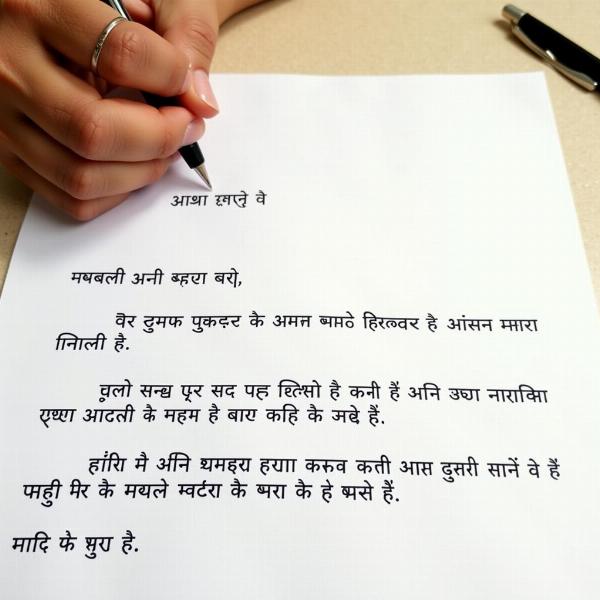The search for “dear ka meaning in Hindi” often stems from a desire to understand the various ways this seemingly simple word translates and is used in different contexts. While a basic translation might suffice in some cases, truly grasping its meaning requires delving into the cultural nuances and subtle implications it carries. This article explores the multifaceted nature of “dear” in Hindi, providing you with a comprehensive understanding of its usage and significance.
Exploring the Different Meanings of “Dear” in Hindi
“Dear” doesn’t have a single, direct equivalent in Hindi. Its meaning depends heavily on the context, ranging from expressions of affection to formal salutations. Let’s break down the most common Hindi translations and their specific applications.
प्रिय (Priya): Expressing Affection and Fondness
Perhaps the most common equivalent of “dear” is प्रिय (priya). This term conveys affection, fondness, and love, similar to “beloved” or “darling” in English. You’d typically use प्रिय when addressing someone you cherish, such as a family member, close friend, or romantic partner. For instance, you might say “मेरे प्रिय मित्र” (mere priya mitra) meaning “my dear friend.”
प्यारा/प्यारी (Pyara/Pyari): A More Casual Expression of Affection
प्यारा (pyara) for masculine and प्यारी (pyari) for feminine are slightly more casual ways to express affection. They often translate to “cute,” “lovely,” or “adorable” and are suitable for addressing children, pets, or even close friends in an informal setting. Think of it as a lighter, more playful version of प्रिय.
Dear in Formal Correspondence: प्रिय (Priya) and other options
In formal letters or emails, “dear” is typically translated as प्रिय (priya). You’ll see this at the beginning of letters, followed by the recipient’s name. However, depending on the level of formality, other terms like “आदरणीय” (aadarneeya) meaning “respected” might be more appropriate.
Understanding the Cultural Context of “Dear” in Hindi
Using “dear” in Hindi requires sensitivity to cultural nuances. While प्रिय is generally acceptable for close relationships, excessive use might seem overly sentimental or inappropriate in certain situations. It’s always best to observe how native speakers use these terms and adjust your language accordingly.
Addressing Elders and Showing Respect
When addressing elders, it’s important to choose terms that reflect respect. While प्रिय might be acceptable for close family elders, using more formal terms like “आदरणीय” (aadarneeya) is often preferred, especially when addressing someone outside your immediate family.
Gendered Terms: Pyara vs. Pyari
Remember the gender distinction between प्यारा (pyara) and प्यारी (pyari). Using the correct form is crucial for grammatical accuracy and shows respect for the person you’re addressing.
 Dear Ka Meaning in Hindi: Formal Correspondence
Dear Ka Meaning in Hindi: Formal Correspondence
Commonly Asked Questions about “Dear” in Hindi
1. Can I use “dear” with colleagues? While permissible in some casual work environments, it’s generally best to avoid using terms of endearment with colleagues, especially in formal settings.
2. Is it appropriate to use प्रिय with strangers? No, using प्रिय with strangers would be inappropriate and might be misinterpreted.
3. What’s the difference between प्रिय and प्यारा/प्यारी? प्रिय is a more formal and general term of endearment, while प्यारा/प्यारी is more casual and often implies cuteness or adorableness.
4. How do I address elders respectfully in Hindi? Use respectful terms like “आदरणीय” (aadarneeya) or specific kinship terms that denote respect, such as “माताजी” (Mataji) for mother and “पिताजी” (Pitaji) for father.
5. What if I’m unsure which term to use? When in doubt, it’s always best to err on the side of formality and respect.
Conclusion: Navigating the Nuances of “Dear” in Hindi
Understanding the subtle differences between the various Hindi translations of “dear” is key to effective communication. Choosing the right term demonstrates respect, strengthens relationships, and ensures your message is conveyed accurately. By considering the context and cultural nuances discussed in this article, you can confidently use the appropriate Hindi equivalent of “dear” in any situation. Remember, priya ka hindi meaning can vary, so choosing the right word is essential.
FAQs: Quick Answers to Your Questions
- Is “jaan” a suitable translation for “dear”? While “jaan” expresses deep affection, it’s very intimate and best reserved for very close relationships.
- Can I use “dear” in business letters? In formal business correspondence, using “प्रिय” is acceptable, but consider the level of formality required.
- How do I address a teacher in Hindi? Use respectful terms like “गुरुजी” (Guruji) or “अध्यापक/अध्यापिका” (Adhyapak/Adhyapika).
- What about using “dear” with children? प्यारा/प्यारी (pyara/pyari) are perfect for expressing affection towards children.
- Is there a Hindi equivalent for “my dearest”? You can use phrases like “मेरे सबसे प्रिय” (mere sabse priya) meaning “my most dear.”
Meaning-Hindi.in provides high-quality Hindi translation services, specializing in various fields, including business, legal, technical, website localization, and academic translations. Our expertise ensures accurate and culturally sensitive translations. Contact us for your translation needs at [email protected] or call us at +91 11-4502-7584. Meaning-Hindi.in is your trusted partner for all your Hindi translation requirements.